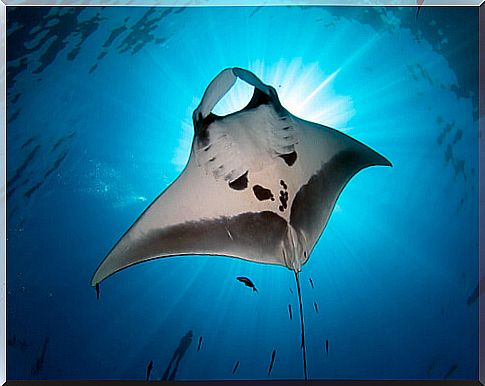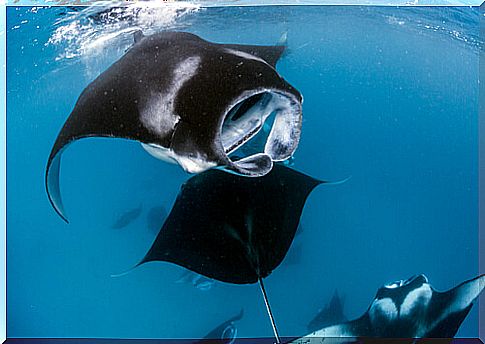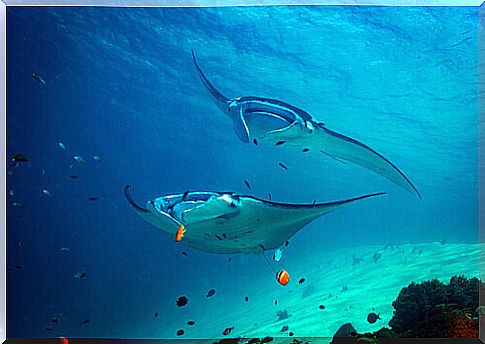The Stingray, Beautiful And Mysterious

The manta ray is a creature that, due to its appearance, has been considered the epitome of marine elegance. Throughout history, this creature was feared due to the similarity that its cephalic fins have with ‘demon horns’, in addition to the fact that the shape of its body resembled a cape.
However, these giants do not pose any threat, as they feed on plankton and are peaceful creatures. Their grace evokes us virtuous dancers who perform an underwater ballet, and is that they fly through the sea performing amazing pirouettes, cartwheels and amazing jumps in the air, out of the water.
This fish has been known by a variety of names around the world. In Spanish, this animal is known as the Atlantic manta, sea devil or ray. In this article you will learn about amazing features of this fish.
The classification of stripes
The manta ray belongs to the class of chondrichthyans or cartilaginous fish that are characterized by having a skeleton entirely composed of cartilaginous tissue. In fact, this group includes different species of sharks and rays.
Cartilaginous fish are characterized by not having a swim bladder or lungs. Respiration is carried out through five to seven pairs of gills open to the outside by slits or gill openings.
This group of fish does not have an operculum, the bony fin that covers and protects the gills in bony fish. Therefore, they do not have that mechanism to control the entry and exit of the water through the gills.

Because of this, cartilaginous fish are forced to remain in constant motion to force the water to penetrate the gills. This means that the manta ray is an animal that never stops swimming, from birth to death.
Cartilaginous fish –elasmobranch– are very archaic, since they have existed for at least around 400 million years
What characterizes the manta ray?
Stingrays and stingrays expanded the wing-shaped pectoral fins. When they swim, they flap their fins in wave motion, similar to that of birds in flight.
They present the gills in the ventral part. The head of both species is broad, with the eyes on each side and the long mouth at the front. In the mouth there are several rows of small teeth that are not used in chewing, but are used so that the males can hold the female during mating.

Two structures called cephalic lobes protrude above the mouth, which extend and direct the flow of water towards the mouth. These structures optimize the feeding process that the manta ray performs by filtering the water to ingest marine plankton, of which they consume a large quantity.
Both species possess a whip-shaped tail. However, unlike other species of the same order, the two species of stingrays lack a poisonous stinger on their tails.
This marine animal is very intelligent: experts recognize that it has the largest brain of all fish. Recently, it has been shown to possess the most highly developed cognitive abilities among fish.
Manta ray habitat
They inhabit seas of tropical waters around the world. Interestingly, stingrays visit ‘maintenance stations’ on reefs, where cleaner fish or opportunistic remoras provide cleaning services for them.
How big is the stingray?
The large, flattened body has a center that is called a ‘disk’. In the case of the reef manta ray, a disc width of 3 to 3.5 meters is reported. In the giant manta ray, the disk can be up to 30 feet wide and weigh as much as 1,350 kilograms.
In general, specimens of four and a half meters are seen. Also, it should be noted that an average stingray can live for about 25 years.

Sensitivity to skin flower
The body of the stingray is covered with a protective mucous membrane. This mucus has two basic functions: it acts as a barrier to infection and reduces friction to facilitate movement when swimming. This membrane can be damaged by human contact, so if you are near a stingray, avoid touching it.
An extraordinary characteristic of stingrays – and all cartilaginous fish – is that they present on their skin an elaborate system of blisters that are sensitive to low-frequency electrical stimuli. These electroreceptors are known as ‘Lorenzini blisters’, and they are decisive for the orientation towards inanimate electric fields, caused by terrestrial geomagnetism and by tides.
The electroreceptor system also allows them to detect electromagnetic fields generated by their potential prey or predators and their congeners during social interactions and mating.
Threats to the manta ray
These fish have been hunted for sport, for their meat, oil, or by mistake in commercial fishing. Currently, the hunting of the manta ray is limited, and in areas such as Hawaii, in the United States, they are a protected species.
The protection of the manta ray is of economic interest, as it attracts a large number of tourists. Without a doubt, this fish adds beauty, diversity, and mystery to our world.








